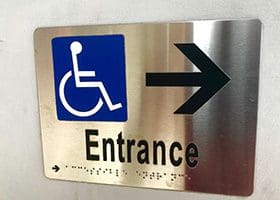Why ADA Compliant Signs Matter
ADA compliant signs are more than just a legal requirement; they are a vital component of creating accessible public spaces. These signs ensure that individuals with disabilities can navigate environments with ease, promoting inclusivity and equal access to information. By adhering to ADA signage compliance, businesses not only fulfill their legal obligations but also demonstrate a commitment to inclusivity and customer care.
Understanding ADA Signage
ADA signage compliance involves meeting specific requirements set forth by the Americans with Disabilities Act. These requirements cover various aspects such as size, font, contrast, and tactile elements. Understanding these ADA signage requirements is crucial for businesses aiming to create an inclusive environment. Proper ADA sign placement and design ensure that all individuals, regardless of ability, can access necessary information.
Why Best Practices Count
Implementing best practices for ADA signs is essential to avoid legal repercussions and enhance user experience. Non-compliance can lead to fines and lawsuits, as well as alienate a significant portion of the consumer base. By following established guidelines, businesses can ensure their signage is both functional and compliant, reflecting their brand’s commitment to accessibility.
Top Practices for ADA Signage Compliance
Know the Requirements
Familiarize yourself with ADA sign standards, including specifications for size, font, contrast, and tactile elements. Compliance is not just about meeting legal standards but also about ensuring accessibility for all.
Perfect Sign Specifications
- Size and Font: Use a minimum height of 5 inches for tactile characters and opt for clear sans-serif fonts. Ensure characters are a mix of uppercase and lowercase, with tactile letters at least 1 inch high.
- Contrast: Maintain a high contrast ratio, aiming for at least 75 LRV, to enhance visibility.
- Braille: Include Grade II Braille, positioned directly below tactile characters, with proper spacing and sizing.
Mount at the Right Height
Install signs with the baseline of tactile characters between 48 and 60 inches above the floor. This range accommodates both standing individuals and those using wheelchairs.
Prioritize Location
Place signs on the latch side of doors for room identification, ensuring they are visible and unobstructed. Maintain a clear path around signs to enhance accessibility.
Use Pictograms and Directions
Incorporate pictograms to aid navigation. Directional and informational signs should provide clear guidance, helping individuals with disabilities navigate spaces effectively.
Maintain and Update Signs
Conduct regular checks to ensure signs remain compliant and in good condition. Promptly clean and replace any damaged signs to maintain accessibility.
Seek Professional Guidance
Engage with professionals specializing in ADA compliance to ensure all signage meets necessary standards. This can help avoid potential legal issues and ensure your signs reflect your brand’s aesthetic.
Helpful Tools and Resources
For further guidance, consider reviewing resources from the Access Board and Accessibility.com. These resources provide detailed insights into ADA sign guidelines and best practices.
Tracking Success and Ongoing Improvement
Regularly assess your signage to ensure ongoing compliance and effectiveness. Solicit feedback from users to identify areas for improvement and make necessary adjustments to enhance accessibility.
FAQs
What are the key elements of ADA compliant signs?
Key elements include size, font, contrast, tactile elements, and Braille. Ensuring these meet ADA sign standards is crucial for compliance.
Why is ADA sign placement important?
Proper placement ensures signs are visible and accessible to all individuals, enhancing navigation and information access.
Final Thoughts and Next Steps
Investing in ADA compliant signs is an investment in inclusivity and customer satisfaction. By following best practices and seeking professional guidance, businesses can ensure their signage meets all necessary requirements while reflecting their brand identity. For tailored solutions, consider consulting with experts like Michigan Custom Signs to explore your options for ADA-compliant signage.

